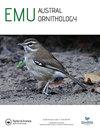城市化对热带城市鸟类形态的影响
IF 1.1
4区 生物学
Q3 ORNITHOLOGY
引用次数: 0
摘要
城市化伴随着重大的环境变化,这些变化会影响群落和生态系统的结构和功能,为动物物种和生态进化动力学带来新的选择机制。我们的目的是评估城市集约化是否促进了巴西中部一个大城市鸟类的生态形态变化。对沿城市集约化梯度捕获的35种1314个个体进行了分析。通过对物种群落的10个生态形态特征和体质量的评估,我们发现了与城市集约化相关的显著形态变化。喙长变化最为显著,随城市密集度的增加而显著缩短,主要表现在食虫和杂食性个体中。这些结果加强了人类活动在密集城市环境中引起的环境变化对留鸟物种产生新的选择压力的观点。关键词:Ecomorphologyurban areaurban animalsurban sprawlurban biodiversityurbanisation强度AcknowledgmentsWe谢谢Rufford基金会的拨款支持,使本研究可能的项目(36888 - 1),巴西的教育机构“Coordenacao de Aperfeicoamento de Pessoal de含量优越”(披肩)博士奖学金EGS,老妈和CNPq研究员奖学金。我们感谢MSD在我们的统计分析过程中提出的宝贵意见,感谢WSP和RNS对研究发展的宝贵贡献。我们也感谢所有志愿者在实地工作期间的协助。这里报告的捕获已获得许可(SISBIO/ICMBio: 73880-4;CEMAVE / ICMBio: 4639/1-2;CEUA / UCB: 001/2020)。披露声明作者未报告潜在的利益冲突。数据可用性声明所有数据均可根据要求提供。地理位置informationBrasília,巴西联邦区(15°47 ' Lat S 47°56 ' Long W).补充数据本文的补充数据可访问https://doi.org/10.1080/01584197.2023.2253836Additional informationfunding .作者感谢Rufford基金会的资助支持,使这项研究成为可能[项目36888-1],巴西教育机构“协调本文章由计算机程序翻译,如有差异,请以英文原文为准。
Urbanisation-induced changes in the morphology of birds from a tropical city
ABSTRACTUrbanisation is accompanied by major environmental changes that impact the structure and functioning of communities and ecosystems, bringing new selective regimes for animal species and for eco-evolutionary dynamics. We aimed to evaluate whether urban intensification promotes ecomorphological changes in birds from a large city in Central Brazil. Analyses were performed on a set of 1314 individuals of 35 species, captured along a gradient of urban intensification. We found significant morphological changes associated with urban intensification by evaluating ten ecomorphological traits and body mass of the species assemblage. Beak length showed the most dramatic changes, and was significantly shorter as a function of urban intensification, mainly in individuals of insectivorous and omnivorous species. These results reinforce the notion that environmental changes caused by human activities in dense urban environments promote new selective pressures in resident bird species.KEYWORDS: Ecomorphologyurban areaurban animalsurban sprawlurban biodiversityurbanisation intensity AcknowledgmentsWe thank the Rufford Foundation for the grant support that made this study possible (Project 36888-1), the Brazilian education agency ‘Coordenação de Aperfeiçoamento de Pessoal de Nível Superior’ (CAPES) for a PhD fellowship to EGS, and CNPq for a researcher fellowship to MÂM. We are grateful to MSD for his valuable comments during our statistical analyses, and WSP and RNS for their valuable contributions to the research development. We also thank all volunteers for their assistance during fieldwork. The captures reported here were licenced (SISBIO/ICMBio: 73880-4; CEMAVE/ICMBio: 4639/1-2; CEUA/UCB: 001/2020).Disclosure statementNo potential conflict of interest was reported by the author(s).Data availability statementAll data are available upon request.Geolocation informationBrasília, Distrito Federal, Brazil (15°47’ Lat S 47°56′ Long W).Supplementary dataSupplemental data for this article can be accessed at https://doi.org/10.1080/01584197.2023.2253836Additional informationFundingThe authors gratefully the Rufford Foundation for the grant support that made this study possible [Project 36888-1], the Brazilian education agency ‘Coordenação de Aperfeiçoamento de Pessoal de Nível Superior’ (CAPES) for a PhD fellowship to EGS, and CNPq for a researcher fellowship to MÂM.
求助全文
通过发布文献求助,成功后即可免费获取论文全文。
去求助
来源期刊

Emu-Austral Ornithology
生物-鸟类学
CiteScore
2.00
自引率
7.70%
发文量
33
审稿时长
>12 weeks
期刊介绍:
Emu – Austral Ornithology is the premier journal for ornithological research and reviews related to the Southern Hemisphere and adjacent tropics. The journal has a long and proud tradition of publishing articles on many aspects of the biology of birds, particularly their conservation and management.
 求助内容:
求助内容: 应助结果提醒方式:
应助结果提醒方式:


